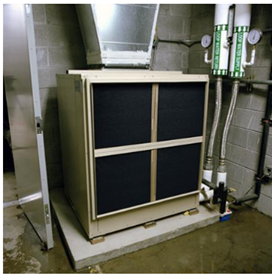Geothermal Heat Pumps
When we talk about alternate energy, geothermal is right there at the top, an effective, efficient and vastly available resource. The subsurface of our planet contains heat in the mechanical and chemical layers. To utilize power from the earth’s heat engine, deep wells are drilled in active tectonic or magmatic zones targeting a specific heat reservoir. The hot water and steam retrieved is used to drive large turbines which in turn power electricity generators.
Do Geothermal pumps provide value for money?
Hyper-efficient heat pumps provide reliable, clean and quiet heating and cooling cutting utility expenditure up to 70%. The installation expense for geothermal heat pumps is a bit on the higher side comparing it to traditional HVAC. However, in all this climate frenzy the current tax rebates, incentives, and financing options make geothermal a viable and smart long-term investment.
Geothermal Heat Pump System
Basically, a geothermal heat pump is not much different from a regular heat pump i.e., utilizing pressurized refrigerant which captures and circulates heat. However, in comparison to conventional systems, geothermal heat pumps transfer heat through long loops of liquid-filled pipe buried in the ground.

Figure 1. A model ground source heat pump system based at a university. Credit: Craig Miller Productions, NREL 02409
Geothermal Heating
As the people before us knew that earth’s temperature in the shallow subsurface remains 50 degrees or so. So, as the conventional heat pump finds it hard to rummage heat from blistering winter air or to throw it into the summer swelter, its cousin the "geothermal source" has a much easier job of extracting and distributing heat via the 50-degree liquid circulating in its ground loop.

Figure 2. A schematic of geothermal heat pump.
Efficiency
Its immensely efficient! Which is why it takes just 1 kWh of electricity in a geothermal heat pump to generate around 12,000 BTUs of heat. Technically, geothermal heat pumps are two times as energy efficient as the top-rated air cons and about 50 % more refined in performance than the top furnaces on a yearly basis. One of the major advantages is that a noisy outdoor fan is not needed to move the air through compressor coils, geothermal pumps essentially pump liquid, making them perfect to park inside. They’re extremely low maintenance and most outlast their warranty coverage.
Geothermal Heat Pump System
Akin to the regular heat pump, a geothermal heat pump’s refrigerant runs in a closed system through the compressor, the condenser, expansion valve and the evaporator, taking heat at one end and delivering it to the other. The main player in this workflow, from what end does the refrigerant flow will be maintained by the reversing valve. This indicates whether heat is moving in or out of the house during winters / summers respectively. If a desuperheater is also added, the residual heat from the system will support a conventional water heater, bringing utility bills down significantly.
To make it work, you have to drill and bury lots of pipes; around 2000 ft. for an average 2,000 sq ft. house. (The actual length which varies must be estimated by a trained professional based on an optimal energy use of the home.) A typical setup mentioned in the above example could cost upward of $15,000 to install, based on site conditions and drilling requirements.
Houses on bigger lots, can have the advantage to use pipes laid horizontally in long, 5 ft deep trenches. Homes on small lots or rocky ledges may require 3 or 4 holes drilled about 500 ft vertically, a much more costly affair.
However, with this astronomical front-end investment, geothermal units are so energy-efficient that the return-on-investment period is quite brief. A research by the Air Force Institute of Technology revealed that it hardly takes on average about 8 to 9 years to recover the investment in terms of saved utilities.
The actual break-even money depends on billing rates, area of interest and its drilling costs, whether the house is insulated, the effectivity of the model chosen, and if your state or utilities provider gives you incentives. An experienced professional who knows about heating as well as the local geology will be making the calculations for installing the heat pumps. Some of the progressive utility vendors often offer incentives like low interest loans to households willing to transform to the technology. And since the plastic ground loops often last many decades or more, the payoff for owners and for the environment has the potential to last for generations.
Major takeaways from geothermal heat pumps include:
- Reduces home heating bills by 30 to 70 %.
- Takes noisy outdoor compressors and fans out of the equation.
- Eliminating GHG emissions equivalent to planting 750 trees or taking off two cars from the road.
Can you retrofit one? Yes, retrofitting a ground-source heat pump system is not difficult, provided that burying the ground loop is doable. A home needs to be designed properly as well or modified if feasible. Ducts need to be installed to circulate heat around the house in such a way that those same ducts are able to provide cold air in summer season. Some geothermal heat pumps are designed to hook up to an existing air handling component, whereas other units come with exclusive integral air handling components. Homes using hot-water heating can also benefit from the installed geothermal systems, however additional radiators will be required because geothermal systems are not designed to reach the higher temperatures of geysers or boilers.
In a nutshell, geothermal technology is an exciting and an almost free resource which has the potential to grow into big business soon. Countries in the Scandinavian region and on the higher altitude are investing big time for making the technology cheaper and sparking public interest by offering them special initiatives and tax rebates. Come to think of it, it’s a vast resource just waiting to be tapped and is the most sensible choice if the progressive minded can change the society’s mindset and end reliance on traditional non renewable sources of energy.
